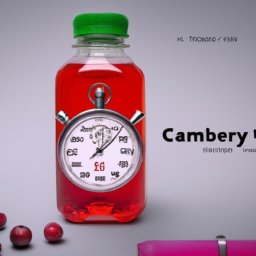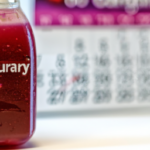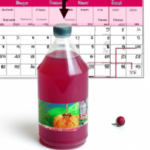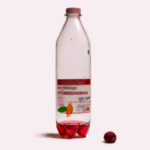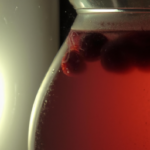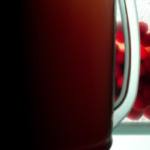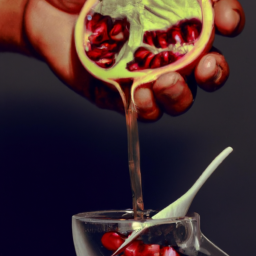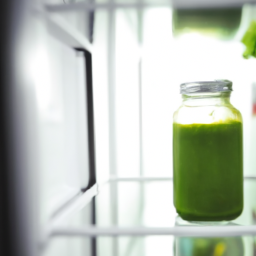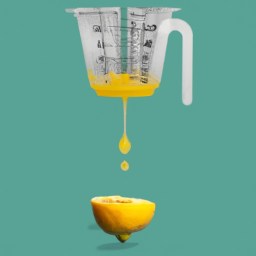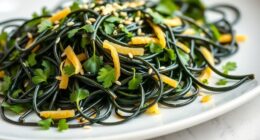I’m a big fan of cranberry juice, however, I’ve always wondered about its shelf life after the bottle has been opened. Being passionate about the safety and quality of the foods and beverages I enjoy, I was keen on learning more about how long cranberry juice can last and the right ways to store it to maintain its freshness.
After conducting research, I discovered that the shelf life of cranberry juice can vary depending on various factors such as the brand, ingredients, and storage conditions.
In this article, I will provide you with information on the shelf life of cranberry juice, how to properly store it, signs of spoiled cranberry juice, and tips for extending its shelf life. Additionally, I will discuss the health risks of drinking spoiled cranberry juice and ways you can use any leftover cranberry juice.
So, let’s dive in and learn more about this delicious and nutritious drink!
Key Takeaways
- Once opened, cranberry juice is exposed to air and bacteria, causing it to spoil faster than when it’s unopened.
- To extend the shelf life of opened cranberry juice, it should be stored in the refrigerator for up to 2 weeks.
- Freezing cranberry juice can also preserve it for up to 6 months, but it may alter its taste and texture.
- Proper storage is crucial in preventing bacterial growth and keeping cranberry juice fresh, and refrigeration is the best method to keep it fresh for a longer period of time.
Shelf Life of Cranberry Juice
So, how long does cranberry juice actually last after you crack open that bottle? Well, it depends on a few factors.
Generally, an unopened bottle of cranberry juice can last up to six months to a year when stored in a cool, dry place. However, once opened, the juice is exposed to air and bacteria, which can cause it to spoil faster.
To extend the shelf life of cranberry juice, there are a few ways to preserve it. One method is to store it in the refrigerator after opening. This will slow down the growth of bacteria and keep the juice fresh for up to two weeks.
Another way to preserve cranberry juice is by freezing it. Simply pour the juice into an airtight container and store it in the freezer for up to six months.
Additionally, there are many recipes using cranberry juice, such as cocktails, marinades, and sauces, that can help to use up any leftover juice.
Now that we know how to extend the life of cranberry juice, let’s talk about the proper storage of cranberry juice.
Proper Storage of Cranberry Juice
I always make sure to properly store my cranberry juice in order to prolong its shelf life. Refrigeration is the best method to keep cranberry juice fresh for a longer period of time.
Freezing is also an option, but it can affect the taste and texture of the juice. Room temperature storage is not recommended, as it can cause the growth of harmful bacteria and spoilage.
Refrigeration
You’ll want to make sure you refrigerate your cranberry juice after opening it to extend its shelf life by an astronomical amount. Refrigeration is crucial in preventing bacterial growth and keeping the juice fresh for a longer period.
When cranberry juice is kept at room temperature, it can start to spoil within a few hours. The importance of refrigeration cannot be stressed enough. Once you open the container of cranberry juice, it’s best to transfer it to a clean, airtight container and place it in the refrigerator.
The ideal temperature for cranberry juice storage is between 33 and 40°F. By following these guidelines, you can expect your cranberry juice to last for up to 10 days in the refrigerator.
Now, let’s move on to the next step of preserving cranberry juice, which is freezing.
Freezing
To keep your cranberry juice fresh for an extended period, pop it in the freezer. Freezing cranberry juice is a great way to extend its shelf life as it can last for up to a year. However, it’s important to note that freezing may alter the taste and texture of the juice.
Frozen cranberry juice can still be used in various ways. It can be used as a base for smoothies and cocktails or as an ingredient in sauces and marinades. When using frozen cranberry juice, it’s important to thaw it out completely before using it to ensure that it’s safe to consume.
Although there may be differences in taste between fresh and frozen cranberry juice, it can still be a great option for those who want to enjoy the benefits of cranberry juice for a longer period of time.
If you prefer the taste of fresh cranberry juice, then storing it at room temperature may be the best option for you. However, it’s important to consume it within a few days of opening as it can spoil quickly.
Room Temperature Storage
If you store cranberry juice at room temperature, it’s crucial to consume it within a few days of opening to ensure it remains fresh and safe to drink. However, if you properly store it, you can enjoy its benefits longer.
Here are some tips on how to properly store cranberry juice at room temperature:
- Keep the juice in a cool, dry place away from direct sunlight.
- Seal the container tightly after each use to prevent air and bacteria from getting in.
- Use a clean glass or plastic container to store the juice, as well as a clean utensil to pour it out.
- Check the expiration date before opening the container, and consume it within a few days after opening.
- If you plan on storing the juice for more than a few days, consider refrigerating it instead.
While cranberry juice can be stored at room temperature for a short period of time, it’s important to be aware of the signs of spoiled juice.
In the next section, we’ll discuss how to identify these signs and ensure that you’re drinking fresh and safe cranberry juice.
Signs of Spoiled Cranberry Juice
Sometimes when you crack open a bottle of cranberry juice, it can start smelling like a dumpster fire after just a few days, making you wonder if it’s still safe to drink. The first sign of spoiled cranberry juice is a sour or off smell. If it smells different than when you first opened it, it’s likely that the juice has gone bad.
Another indicator of spoilage is the presence of mold or bubbles on the surface of the juice. While drinking spoiled cranberry juice can lead to health risks, there are other ways to use it. For example, you can use it as a DIY face mask.
Cranberry juice is packed with antioxidants and vitamins that can help improve the texture of your skin. Mix cranberry juice with honey and apply it to your face for 15 minutes before rinsing it off. However, if your cranberry juice is spoiled, it’s best to dispose of it properly. Drinking spoiled cranberry juice can lead to stomach upset, diarrhea, and even food poisoning.
Health Risks of Drinking Spoiled Cranberry Juice
Be cautious of drinking spoiled cranberry juice, as it can result in stomach upset, diarrhea, and even food poisoning. Consuming spoiled cranberry juice can also lead to urinary tract infections (UTIs) and negatively impact kidney health. This is because cranberries contain compounds that can prevent bacteria from adhering to the bladder and urinary tract walls, reducing the risk of UTIs.
However, when cranberry juice is spoiled, it can no longer provide these benefits and may even introduce harmful bacteria into the body. To prevent these health risks, it’s important to properly store cranberry juice and consume it before the expiration date. It’s also recommended to only purchase cranberry juice from reputable sources to ensure that it has been properly processed and preserved.
By taking these steps, you can continue to enjoy the health benefits of cranberry juice while avoiding potential health hazards.
Moving forward, there are several tips for extending the shelf life of cranberry juice.
Tips for Extending the Shelf Life of Cranberry Juice
In order to avoid health risks associated with drinking spoiled cranberry juice, it’s important to understand how to extend its shelf life. As someone who enjoys incorporating cranberry juice into my daily routine, I’ve done some research and found a few tips that have helped me keep my cranberry juice fresh for longer.
Firstly, it’s important to store cranberry juice properly. Once opened, it should be refrigerated and consumed within 7-10 days. However, there are ways to extend its shelf life beyond that timeframe.
Here are a few tips that have worked for me:
-
Freeze it: Pour leftover cranberry juice into ice cube trays and freeze for later use in smoothies or as a flavorful addition to water.
-
Mix it up: Use cranberry juice as a base for homemade salad dressings or marinades for meats and vegetables. It adds a tangy flavor that pairs perfectly with savory dishes.
By utilizing these tips, you can ensure that your cranberry juice stays fresh for longer and find creative uses for leftover juice.
In the next section, we’ll go over how to tell if cranberry juice has gone bad.
How to Tell if Cranberry Juice has Gone Bad
As someone who regularly consumes cranberry juice, it’s important to know how to tell if it has gone bad.
There are three key factors to consider: smell, taste, and appearance.
The smell of spoiled cranberry juice will be noticeably sour or musty, while the taste might be overly acidic or off-putting.
Additionally, mold or cloudiness in the appearance of the juice is a clear indication that it’s time to throw it out.
Smell
You’ll notice a distinct change in the smell of your cranberry juice after it’s been opened for a few days. The once sweet and refreshing scent will turn sour and pungent. This is a clear indication that your cranberry juice has started to spoil.
Here are some things to keep in mind when it comes to the smell of your cranberry juice:
- Spoiled cranberry juice will give off a musty or moldy smell.
- Adding sugar or other sweeteners can help mask the sour smell of spoiled cranberry juice, but it won’t improve its quality or health benefits.
- Consuming spoiled cranberry juice can lead to food poisoning, which can cause symptoms such as diarrhea, vomiting, and fever.
- Storing cranberry juice in a cool and dry place can help prolong its shelf life.
- Always check the expiration date on the bottle before consuming cranberry juice.
Moving on to the next subtopic, the change in smell is often accompanied by a change in taste.
Taste
The taste of spoiled cranberry juice, on the other hand, is a sharp contrast to its once refreshing flavor. When cranberry juice goes bad, it can taste sour, bitter, or even metallic. The taste may become more acidic or vinegary, and it can leave an unpleasant aftertaste in your mouth. It’s important to note that expired cranberry juice may also cause stomach discomfort and diarrhea if consumed.
To avoid wasting cranberry juice, there are ways to enhance its flavor and extend its shelf life. One way is to mix it with other juices or sweeteners to balance out its tartness. Additionally, cooking with cranberry juice can add a unique flavor to dishes, such as in marinades, sauces, and jams. By utilizing these strategies, you can enjoy the benefits of cranberry juice beyond its expiration date.
Moving on to the appearance of cranberry juice, it’s important to note that spoilage can also affect its color and texture.
Appearance
Hey there, have you ever noticed how the color and texture of cranberry juice can change when it spoils? When cranberry juice goes bad, it can turn brown and murky, losing its vibrant red hue. The texture can also become thicker and slimy, which is a clear indication that it has gone bad.
To enhance the appearance of cranberry juice and prevent it from spoiling, there are a few things you can do. Firstly, storing cranberry juice in a cool and dry place can help preserve its color and texture. Secondly, adding a little bit of lemon juice can help maintain its vibrant red color for a longer period. Lastly, drinking cranberry juice has been shown to have benefits for skin health, as it contains antioxidants that can help improve skin elasticity and prevent premature aging.
As for ways to use leftover cranberry juice, there are many creative options. One idea is to use it as a natural food coloring for baked goods or cocktails. Another option is to freeze it in ice cube trays and use the cubes to add flavor to water or other beverages. With a little bit of creativity, leftover cranberry juice can be a versatile ingredient in many recipes.
Ways to Use Leftover Cranberry Juice
Imagine you’re a chef in a fancy restaurant, and you have some leftover cranberry juice that you don’t want to waste. Why not create a tangy cranberry vinaigrette for your salads? Here are three ideas for using up that leftover juice in creative and delicious ways:
-
Cranberry Spritzer: Mix cranberry juice with sparkling water and a splash of lime juice for a refreshing and low-calorie drink that’s perfect for sipping on a hot summer day.
-
Cranberry Margarita: Combine cranberry juice, tequila, triple sec, and lime juice in a shaker with ice, then strain into a salt-rimmed glass for a festive and fruity twist on the classic margarita.
-
Cranberry BBQ Sauce: Combine cranberry juice, ketchup, apple cider vinegar, brown sugar, and spices in a saucepan and simmer until thickened. Then, use as a glaze for grilled chicken or pork for a sweet and tangy flavor.
Using up leftover cranberry juice in these creative ways not only helps reduce food waste but also adds unique flavors to your drinks and dishes. And if you still have some extra juice, don’t worry – there are even more benefits to drinking cranberry juice, as we’ll explore in the next section.
Benefits of Drinking Cranberry Juice
As someone who’s health-conscious, I find it important to know the benefits of drinking cranberry juice.
Firstly, it’s known to prevent urinary tract infections (UTIs) due to its ability to prevent bacteria from sticking to the bladder walls.
Secondly, cranberry juice is rich in antioxidants, which can help protect the body from damage caused by free radicals.
Lastly, studies have shown that drinking cranberry juice may improve heart health by reducing inflammation and improving cholesterol levels.
UTI Prevention
You’ll be happy to know that drinking cranberry juice daily can help prevent UTIs. UTIs, or urinary tract infections, are caused by bacteria entering the urinary tract and multiplying.
Cranberry juice contains compounds called proanthocyanidins, which can prevent bacteria from sticking to the walls of the urinary tract. This makes it harder for bacteria to grow and cause an infection.
While antibiotics are commonly used to treat UTIs, natural remedies and alternative therapies like cranberry juice can be effective in preventing UTIs from occurring in the first place. Studies have shown that drinking cranberry juice daily can reduce the recurrence of UTIs in women with a history of recurrent UTIs.
So, if you’re looking for a natural way to prevent UTIs, incorporating cranberry juice into your daily routine may be a good option.
Drinking cranberry juice can also provide other benefits due to its antioxidant properties. Antioxidants are compounds that protect cells from damage caused by free radicals, which are unstable molecules that can harm cells and contribute to the development of diseases like cancer and heart disease.
Cranberry juice is a good source of antioxidants, making it a healthy addition to your diet.
Antioxidant Properties
To get the most out of its antioxidant properties, try incorporating cranberry juice into your daily routine. Cranberries are known for their high levels of polyphenols, which are compounds that act as antioxidants in the body. These polyphenols help to protect cells from damage caused by free radicals, which are unstable molecules that can cause inflammation and contribute to chronic diseases.
One way to incorporate cranberry juice into your daily routine is by adding it to your morning smoothie. You can also try mixing it with sparkling water for a refreshing beverage or using it as a base for marinades and salad dressings.
If you’re looking for alternatives to cranberry juice, consider trying other fruits and vegetables that are high in antioxidants, such as blueberries, pomegranates, and spinach.
Now, let’s explore how cranberry juice can benefit heart health.
Heart Health
If you want to keep your heart healthy, incorporating cranberry juice into your diet can help. Research studies have shown that cranberry juice can lower the risk of heart disease by reducing inflammation and improving cholesterol levels. The polyphenols found in cranberry juice, specifically flavonoids and proanthocyanidins, have been found to have a positive effect on cardiovascular health.
To reap the maximum benefits of cranberry juice for heart health, it is important to consume the recommended dosage. According to research, drinking 8-16 ounces of cranberry juice per day can improve cholesterol levels and reduce the risk of heart disease. However, it is important to note that drinking excessive amounts of cranberry juice can lead to gastrointestinal issues and increase the risk of kidney stones. Therefore, it is crucial to consult with a healthcare professional before adding cranberry juice to your diet and to follow the recommended dosage.
Moving into the subsequent section about other types of cranberry juice, it is important to consider the sugar content and added ingredients in certain brands.
Other Types of Cranberry Juice
Let’s explore the shelf life of various types of cranberry juice once the bottle is opened. Different types of cranberry juice have varying shelf lives, and it’s essential to know how long each type of juice can last to avoid consuming expired juice.
Here are some of the different types of cranberry juice and their respective shelf lives:
-
100% pure cranberry juice: Once opened, the juice can last for up to two weeks when refrigerated. However, it’s best to consume it within seven days of opening since the juice can lose its nutritional value over time.
-
Cranberry juice cocktail: This type of juice usually contains added sweeteners and preservatives, which can extend its shelf life. After opening, cranberry juice cocktail can last for up to three weeks when refrigerated.
-
Cranberry juice blends: These juices are usually a mixture of cranberry juice and other fruit juices. The shelf life of cranberry juice blends varies depending on the other fruit juices used. However, on average, they can last for up to two weeks after opening when refrigerated.
Knowing the shelf life of different types of cranberry juice can help you plan your consumption and avoid wastage. Additionally, it’s essential to note that mixing options can affect the shelf life of cranberry juice. For instance, adding water or ice to the juice can dilute it, reducing its shelf life. Therefore, it’s advisable to consume the juice as it is or refrigerate it immediately after mixing.
Frequently Asked Questions
Can cranberry juice be frozen to extend its shelf life?
Yes, cranberry juice can be frozen to extend its shelf life. Properly freezing and thawing methods should be followed to maintain quality. Always leave space for expansion and use within 6-8 months for best results.
Is it safe to drink cranberry juice that has been left out at room temperature for a few hours?
Drinking cranberry juice left out at room temperature for a few hours can be risky due to bacteria growth. The ideal drinking temperature is chilled, which can also slow the growth of harmful bacteria.
Can cranberry juice help prevent urinary tract infections?
Cranberry juice has been shown to have benefits in preventing urinary tract infections. A recommended dosage is 8 ounces of juice per day. Studies have found that the active compounds in cranberries can help prevent bacteria from adhering to the bladder.
Can cranberry juice be used as a substitute for other juices in recipes?
Did you know that cranberry juice has a higher antioxidant content than other fruit juices? Substitution options for cranberry juice in recipes include apple or grape juice. Its tart flavor profile pairs well with savory dishes like marinades and glazes.
What is the difference between regular cranberry juice and cranberry juice cocktail?
Cranberry juice varieties differ in nutritional content. While regular cranberry juice is pure and tart, cranberry juice cocktail contains added sugars and other juices for a sweeter taste.
Conclusion
Well, folks, it looks like we’ve come to the end of our cranberry juice journey. After diving into the shelf life, proper storage, signs of spoilage, health risks, and benefits of this tart drink, it’s clear that cranberry juice is not to be taken lightly.
As I reflect on all that I’ve learned, I can’t help but feel like a cranberry juice connoisseur. I’ve got my storage techniques down pat, I know exactly how to tell if my juice has gone bad, and I’ve even discovered creative ways to use up leftover juice.
So, the next time you’re sipping on a glass of cranberry juice, remember that it’s not just a tasty beverage, but a powerful tool for improving your health. And, with the right knowledge and care, you can enjoy this antioxidant-rich drink for weeks to come.
Cheers to cranberry juice!
Ilana has been a vegan for over 10 years. She originally made the switch for health reasons, but soon found herself becoming more and more passionate about the ethical and environmental implications of a vegan lifestyle. Ilana is the author of The Graceful Kitchen, a blog all about veganism. She loves to cook up delicious and nutritious vegan meals, and share her recipes with others who are interested in leading a cruelty-free life. Ilana is also a strong advocate for using whole foods as the foundation of a healthy diet, and believes that going vegan is one of the best ways to achieve this.
